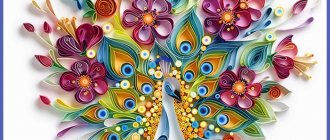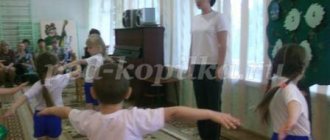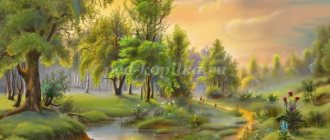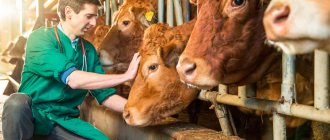"My family". Summary of GCD in the middle group
Integration of educational areas: communication, socialization, cognition.
Communication: Introduce the concept of “family”. Give children initial ideas about family relationships: each child is simultaneously a son (daughter), grandson (granddaughter), brother (sister); mom and dad – daughter and son of grandparents.
Socialization: Cultivate a sensitive attitude towards the closest people - family members. To develop the ability to observe the rules of cultural behavior during the game. Develop the ability to select objects and attributes for the game.
Cognition: Expand children's understanding of the family (its members, family relationships) and its history; that the family is everyone who lives with the child.
Material: Matryoshka doll with six nesting doll inserts, ball, basket, 3 sets of pictures (grandmother, grandfather, mom, dad, sister, brother, cat, dog, birds, fish), 3 sheets of A3 white paper, text of a poem by S. Marshak “Matryoshka dolls”, photographs of family members of the children and the teacher, one common family photo each of the children and the teacher, a tablet (typesetting canvas) for posting photographs.
Preliminary work: Learning finger games “Who lives in the family.” Telling and reading fairy tales “The Three Bears”, “A Goat with Kids”, “The Three Little Pigs”; poem by A. Barto “Two sisters look at their brother.” Album "How I spent my summer." Games: role-playing game “Family”; didactic games “Let’s set the table for tea,” “Daddy’s, Mommy’s household,” “Let’s help mommy.” A conversation about what to call your parents, grandparents.
Progress of activities:
Teacher: Guys, try to guess the riddle and find the answer in the group, on the shelf with toys.
In this girl doll
The sisters are hiding.
Every sister
For the smaller dungeon.
(Matryoshka)
Teacher: Well done guys, you guessed the answer, picks up the matryoshka doll. Would you like to meet our guest Matryoshka?
Children: Yes.
(The teacher, on behalf of Matryoshka, introduces himself to the children: “My name is Grandma Matryona.”)
Grandmother Matryona: I am a wooden doll, chubby, ruddy. In a multi-colored sundress, with a lace scarf in his pocket. I didn’t come to visit alone. With me is my husband - grandfather Anton, my two daughters Masha and Dasha, and my grandchildren: Marishka, Irishka and Timoshka - a little bigger than a nut.”
Teacher: Guys, where are the listed relatives of Grandma Matryona? Try to find them.
(Children look for and find nesting dolls in a large nesting doll. All nesting dolls are displayed on the table)
Teacher. Guys, can we say that all the nesting dolls are one big, friendly family?
Children: Yes.
Teacher: Why? (Children's reasoning.) Grandmother Matryona loves to play different games with her grandchildren, and she used to play with her daughters when they were little. She wants to play with them and with you.
A didactic reasoning game “Who left? Who's come?"
(The teacher names the actions and manipulates the toys, the children name the names of the nesting dolls.)
Teacher. The grandmother left... (Matryona.) Her eldest daughter came... (Masha.) The eldest daughter left, her two daughters came running... (Marishka and Irishka.) The girls ran away, the grandfather came... (Anton.) Another daughter came to grandfather Anton... (Dasha .) Dasha’s little son also came... (Timoshka.) Grandfather... (Anton), daughter... (Dasha) and little grandson... (Timoshka) left, and grandmother Matryona came again.
Grandmother Matryona . What kind of families do you guys have? Who is in Oleg’s family (Natasha, Dinara, Yaroslav)? I suggest you try to create a portrait of your family from pictures.
The game “Make a portrait of your family” is played
Three children take part in the game. On the carpet are sheets of white A3 paper and three sets of pictures (grandmother, grandfather, mother, father, sister, brother, cat, dog, birds, fish). The teacher invites each child to make a portrait of his family from pictures.
The game is repeated 2-3 times.
Grandmother Matryona: (Praises the children). Family is the most precious thing a person has. All family members love each other and take care of each other.
Teacher. (addressing Matryona). You know, Matryonushka, our children like to look at photographs of their family. Let's tell stories about family niches. I will tell the first family story. (Puts the photograph on the easel.) This photograph shows my family in the summer at the dacha. Our whole family loves to grow vegetables, swim in the river, sunbathe, and relax. In this photo, my closest relatives are my husband and our son.
(Next, the children who want to tell from the photographs tell about their family. Grandma Matryona puts all the photographs on an easel, praises the children for interesting stories about the family and draws attention to the fact that in all the photographs family members are smiling, are close to each other - they feel good together) .
Then the teacher shows the children individual photographs of their family members and asks questions:
- Who is Camille to his mother? (Kamil is his mother's son.)
- Whose children are Varvara and Lena? (Children of mom and dad.)
- Whose grandchildren are they? (Grandchildren of grandparents.)
- Whose mother is this? (Mom of Sophia, daughters, girls.)
- Whose grandmother is this? (Grandmother of Edik and Kamil.)
Grandmother Matryona: I love my affectionate grandchildren very much (asks the guys if they know how to be affectionate)
Children: Yes.
The ball game “Name it kindly” is played
Children stand in a circle. In the center of the circle stands a teacher with a ball. He throws the ball to the child and calls any family member, for example: “Mom” (father, brother, sister, grandmother, grandfather). The child who catches the ball must call his mother affectionately (mommy, mummy, mummy, mother).
Teacher: (Points to the basket that Grandma Matryona brought with her) “Whoever Grandma Matryona places a basket on the palm of her hand must put in it the good deeds that the whole family does at home.”
Children stand in a circle. The teacher walks in a circle, places a basket in the child’s palm, and the child names good deeds of the whole family (cooking delicious food, going to the store, caring for a sick grandfather, washing dishes, washing clothes, vacuuming, walking the dog, working in the country, etc.). d.).
Grandmother Matryona: Thank you guys for the full basket of good deeds.
Teacher: Thanks Grandma Matryona, the children and concludes: “You all have mothers, fathers, grandmothers, grandfathers, some have a brother, a sister. This is family. Family members live together, love each other and take care of each other. Every person really needs a family. A family can be large or small. The main thing is that family members love each other, be attentive and caring towards each other.”
In conclusion, Grandma Matryona invites her large family and all the children to drink tea and cake.
Author: Matveeva Elvira Umerovna,
teacher at Almetyevsk MDOU -
combined kindergarten No. 51 “Rainbow”
Almetyevsk RT
The article is published in the author's edition
GCD on the topic “My Family” in the middle group
(Teacher of MAOU Secondary School No. 43 Kucherenko M.N..)
Program content : - Strengthen children's ideas about family.
- to form in children elementary ideas about family members as people of different genders and ages, united by kinship.
- All family members are obliged to protect their child.
- cultivate love for all family members.
Material for the lesson : vocabulary word elderly, family illustrations. Children's stories that they themselves composed at home with their parents on the topic “My Family”, pictures from fairy tales with family, created situations. Drawings of your family.
Progress of the lesson:
Guys, today I brought you a riddle. You will guess it and understand what we will talk about today. 7th.
Riddle: Everyone knows this word, and wouldn’t trade it for anything! I’ll add “I” to the number “seven.” What will happen? (Family)
Children: Family
Educator: Well done! Every person has his own family. Raise your hand those who believe that they live in a family. Tell me, who do you call members of your family?
Children: grandmother, grandfather, mother, father, brothers, sisters.
Educator: let's look at photographs of some families (the teacher flips through the album pages). On them we see men, women, girls and boys (the teacher speaks with a pause, waiting for the children to help him finish). Now take a look at the work your families have done at home – well done! Who wants to talk about their family?
— Children tell (3-4 children).
Educator: tell me, who can be the men in the family? Children: father, grandfather, brother (son) Educator: who in the family can be a woman? Children: mother, grandmother, sister (daughter) Educator: who are people divided into by age? Children: children, adults and elderly. Educator: addresses one of the children, for example, Nikita, who would you classify as the elderly?
Physical education minute:
standing, the children talk, massaging their fingers, about all members of the friendly family.
This finger is grandpa, This finger is grandma, This finger is daddy, This finger is mummy, This finger is me, That’s my whole family.
Educator: tell me how they take care of you in your friendly family? - Do you like this and why? — what feelings do you experience when you are at home?
Children answer the teacher's questions. Now you have named the feelings that you experience in your family, such as joy, love, care, affection, a sense of security.
People have a lot of proverbs about family, about mothers. - the whole family is together, and the soul is in the right place! - there is no dearer friend than your own mother
What proverbs do you know? Children read. Well done!
And now I ask you to pay attention to these illustrations. Who do you see in them? Children speak from illustrations. The teacher concludes: the artists loved to depict families, separately a mother and child, etc. Poems were also written about the family. Teacher: but listen to a poem about the family
Family means happiness, love and luck, Family means trips to the country in the summer. Family is a holiday, family dates, gifts, shopping, pleasant spending. Family is work, taking care of each other, Family is a lot of homework. Family is important! Family is difficult! But it is impossible to live happily alone! Educator: It is very important when family members take care of their child. After all, even animals live in families and take care of their children. Look around you and find in the group fragments from fairy tales where animals live as a family and take care of their young.
Children see and name fairy tales: The Three Little Pigs, The Three Bears (situation from toys), illustrations: “The Wolf and the Seven Little Goats”
The teacher summarizes the lesson: “We all have families too. For your parents you are sons and daughters, for your grandparents you are grandchildren and granddaughters. Some of you have brothers or sisters to whom you are also a brother or sister. We all love our relatives very much, we try to take care of them, not to upset or upset them, to feel sorry for them, to help them, to speak kind and affectionate words.”



